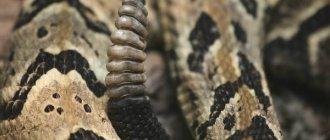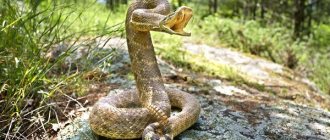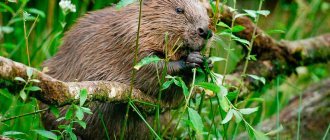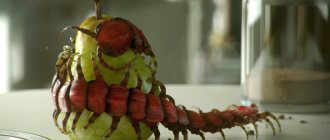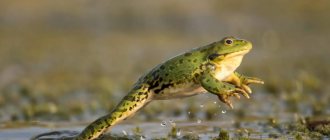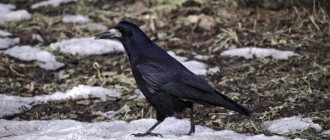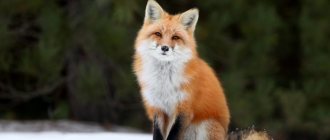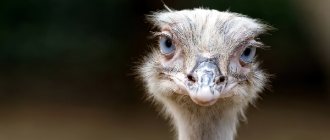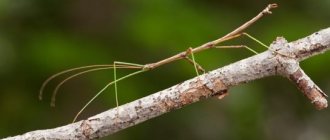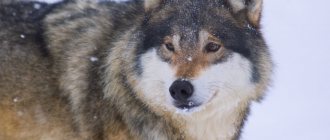“You will step on the asp and the basilisk; You will trample on the lion and the dragon,” says the Lord through the mouth of the prophet and king David in Psalm 90. Is an asp a poisonous snake, a dragon or evil spirits? What creatures we are talking about was explained by Archpriest Georgy Gorodentsev. The text is illustrated with funny pictures.
Asp. Illustration from a British Library manuscript
Description of the species
Due to the large number of representatives, there is a diversity of appearance and lifestyle.
The slender build, smooth scales on the back and symmetrical elements on the neck create a resemblance to snakes. There is a small ridge on the back behind the head. The cervical part of the spine is practically not distinguished relative to the thoracic spine.
The body length varies widely - from 18 cm in the white-lipped snake to 5.85 m in the king cobra.
List of main general parameters:
- all representatives are poisonous, some have extremely dangerous poison;
- have hollow and immobile fangs that inject poison into the body of the victim;
- long slender body with smooth scales;
- the vast majority of representatives are oviparous;
- They prefer active hunting to ambushes.
Cobras have flexible thoracic and lumbar ribs that allow them to open their “hood.” Most of these representatives have a round pupil, despite the common rule that venomous snakes have a vertical pupillary sphincter.
There is no left lung. Rudiments of the pelvic bone and limbs are noticeable only in some representatives. The body color is varied, but when comparing all species, a pattern is revealed: small snakes are brightly colored (as befits carriers of poison), and the skin color of large ones corresponds to the area in which they live.
Nutritional Features
Adders exhibit diversity in their food choices. Victims of poisonous snakes can include:
- mammals;
- birds;
- reptiles (lizards or small snakes);
- fish;
- amphibians.
Most representatives eat “everything”; some specialize in two or three types of game. In conditions of active hunting, you have to be content with what you managed to catch, so omnivory gives an advantage to the animals.
Sea snakes eat fish, squid and eels. Active hunting involves long pursuit, waiting for the right moment, and an attack with the introduction of poison.
After poisoning, the hunter waits. Until the victim dies or becomes paralyzed from the poison to eat in peace. The toxic poison stops the heart and breathing of small and medium-sized animals, so you don't have to wait long.
Some species use sophisticated hunting methods. The viper-shaped death snake, for example, imitates the movements of the larva with the tip of its tail. The victim becomes interested, bites the predator's tail, and dies itself from the reptile's bite.
Mulga
The brown king - this is the name of this Australian snake, lives in deserts, light forests, meadows and pastures. Possessing considerable size, she treats people without fear. When faced with danger, the mulga expands its neck muscles, indicating that it is better not to approach it. This can serve as a signal to a person that she is ready to attack, so the only way out is to freeze in place and not provoke. You should not try to run away from her, as she reacts to movement and can rush after you. Deaths after meeting with a mulga are not uncommon, since when bitten it releases a huge amount of poison - about 150 mg.
Habitat of adders
Reptiles can be found in the tropics and subtropics in Asia, Australia, Africa, North and South America. Some species are found in temperate latitudes. Aquatic versions live in the Pacific and Indian oceans.
Australia is considered the historical homeland of reptiles of this family, since the most ancient representatives, as well as most of the genus, live on this continent. Due to convergent adaptation, species began to appear that outwardly resembled representatives of the family Pitaceae.
Late species do not penetrate this continent, making it easier for herpertologists to observe the development of the family.
In Africa, you can also find ancient species, since this place is the second center of distribution of asps. Only on this continent are found arboreal species and those species that live only in the water surface.
The population of Asia is represented by young species of animals that have adapted to life on this land. Most reptiles here lead a terrestrial or burrowing lifestyle. The largest species represented in the family is the king cobra.
The American continents received adders later than everyone else, so not so many snakes live here, and they are not so diverse. All continental inhabitants have a shortened upper jaw and a reduced number of teeth.
The distribution area of reptiles is practically unlimited - they can live in wet forests, dry steppes or deserts. Animals are highly adaptable.
Indian krait
It is considered one of the most poisonous representatives of the krait family. His middle name is Blue Bungarus. It lives in South Asian countries, including India and Sri Lanka. A black snake with white transverse stripes seems quite harmless in appearance. But in fact, her glands contain at least 5 lethal doses of poison. Meetings with people happen regularly, as Indian kraits love to climb into houses and basements. During the day, a person has every chance of avoiding a fatal bite, since at this time of day snakes are least inclined to confrontation. But at night they can attack the sleeping owner of the home without any reason. The poison of the Indian krait is very toxic, the mortality rate is high even among people who have managed to administer the antidote.
Reproduction and lifespan
Reproduction occurs once a year, in the spring. During this period of time, males fight for females, after which the winners begin copulation. Most members of the family are oviparous.
For those living in cool climates, live birth is possible. This is believed to help control the temperature of the offspring.
Reptiles that lead a burrowing lifestyle are ovoviviparous. This transitional form of breeding serves as an adaptation to unstable environmental conditions. Some Australian reptiles practice hatching eggs inside their bodies and giving birth to live young.
Puberty occurs a year after birth. Some species can only give birth to offspring at the age of two. Pregnancy lasts more than two months. The number of eggs in one litter is 10-50. Up to 60 individuals can be born alive. They live on average from 20 to 30 years.
Snake behavior
Among the representatives there are individuals with an aggressive or phlegmatic temperament. Most do not show aggression towards larger creatures, such as humans.
But reptiles have no fear of creatures that are larger in size. Asps often settle near human dwellings and penetrate human settlements, trying to find food. People living next to reptiles learn to coexist peacefully.
The animal hunts mainly during the daytime. If the weather is hot, then the creature waits for the evening. One or two animals may be enough for the whole day, but if the opportunity arises, the snake will not refuse the supplement.
Reptiles can eat for future use and then digest what they swallow for several days.
There are known cases when a snake attacked large animals or people without direct contact (no one stepped on it), but due to close proximity. Having bitten once, the asp began to pursue the victim, trying to finish it off.
The reptile can reach speeds of up to 10 km/h during pursuit or retreat.
Sandy efa
A small snake from the viper family is common in the arid places of Central and South Asia, as well as in North Africa and the Arabian Peninsula. She tries not to approach people, but she is not afraid of them either. When meeting, she will first warn of her determination with a loud rustling sound, and if she considers that the person is an enemy, she will rush at him with the speed of lightning. This viper is responsible for many human lives; approximately every fifth person dies. Once in the blood, the poison of efa disrupts its coagulation, causing a person to experience multiple internal and external bleeding. Even timely medical care does not guarantee the survival of the bitten person. The poison can gradually kill a person, with the result that death occurs only a few days after the bite.
Asp venom
All members of the family are armed with teeth, from which they release poison when bitten. Some species can shoot jets of poison at an enemy, hitting them from a distance (in most cases, the consequences are temporary loss of vision, which gives the attacker an advantage).
Most species have a poison that is lethal to humans, killing in 7 minutes. People living in proximity to snakes have adapted to wear high boots and clothes made of thick fabric that snake fangs cannot bite through.
The villages are inhabited by healers who know how to help victims of a collision with an asp. Pigs are immune to poison, and farmers use these animals to check for poisonous neighbors walking nearby.
The teeth of adders are immobile, with the exception of the viper-shaped death snake found in Australia. The square bone of its upper jaw, on which the teeth with channels for poison are located, can tilt, simplifying the task of poisoning the victim.
Some species of poison are not toxic enough to cause death in humans. However, the consequences of the bite still affect you as a bad feeling, so you should not neglect the help of a specialist.
The main active substance in the poison is neutrotoxins. Local manifestation is not recorded (the bite points do not show inflammation or redness), but rapid depression of the nervous system, paralysis of the respiratory tract and death are noted.
Black Mamba
The snake with the Mona Lisa smile is poisonous and dangerous. This resident of the African tropics will not intentionally attack a person, but if she feels threatened, she will definitely take the fight. To begin with, she will try to put the enemy to flight by showing him her terrible black mouth. If this doesn't work, the snake will deliver a series of venomous bites. At one time she injects so much poison that it would be possible to kill 10 people at once. Anyone bitten by a black mamba will feel a sharp pain in the place where he was stung. After a short time, he will begin to show signs of poisoning: he will begin to feel sick, have diarrhea, abdominal pain, dizziness, and others. If the antidote is not administered in time, the person will die a quick but painful death from suffocation.
List of subspecies
The asp family (Elapidae) has about 350 species, which are grouped into six dozen genera. Conventionally, they can be divided according to lifestyle with examples of subspecies:
Leading an arboreal lifestyle:
- tree cobra;
- green mamba;
- narrow-headed mamba;
- black Mamba.
Snakes that live primarily in water:
- ringed water cobra;
- coral adder;
- ribbon coral adder;
- cobra adder
Reptiles that dig burrows as shelters:
- bandy-bandy;
- southern simoselapse;
- Arizona adder.
Animals that live exclusively on land:
- coral Hatori;
- the magnificent Australian copperhead;
- South African shield;
- coastal taipan.
Since representatives of the family live on different continents, they develop in isolation from each other, giving rise to a diversity of species.
Classification
As of September 2022, the subfamily includes 3 subfamilies and 56 genera[9]:
- Subfamily Elapinae Boie, 1827
Acanthophis Daudin, 1803 - Deadly snakes - Antaioserpens Wells & Wellington, 1985
- Aspidelaps Fitzinger, 1843
- Aspidomorphus Fitzinger, 1843 - False adders
- Austrelaps Worrell, 1963 - Australian Copperhead Snakes
- Brachyurophis Günther, 1863 - Australian coral adders
- Bungarus Daudin, 1803 – Craits
- Cacophis Günther, 1863 - Australian crowned snakes
- Calliophis Gray, 1835 – Decorated adders
- Cryptophis Worrell, 1961
- Demansia Gray, 1842
- Dendroaspis Schlegel, 1848 - Mambas
- Denisonia Krefft, 1869
- Drysdalia Worrell, 1961 – Crowned adders
- Echiopsis Fitzinger, 1843
- Elapognathus Boulenger, 1896
- Elapsoidea Bocage, 1866 - African spotted adder
- Furina Dumeril, 1853
- Hemachatus Fleming, 1822 - Collared cobras
- Hemiaspis Fitzinger, 1861 - Swamp adders
- Hemibungarus Peters, 1862
- Hoplocephalus Wagler, 1830
- Loveridgelaps McDowell, 1970
- Micropechis Boulenger, 1896
- Micruroides Schmidt, 1928 - Arizona adders
- Micrurus Wagler, 1824 – Coral adder
- Naja Laurenti, 1768 – Cobras
- Neelaps Günther, 1863 - Black-necked adder
- Notechis Boulenger, 1896 - Tiger Snakes
- Ogmodon Peters, 1864 - Fiji adders
- Ophiophagus Günther, 1864 – King Cobras
- Oxyuranus Kinghorn, 1923 - Taipans
- Parapistocalamus Roux, 1934
- Parasuta Worrell, 1961
- Paroplocephalus Keogh, Scott & Scanlon, 2000
- Pseudechis Wagler, 1830 - Black Snakes
- Pseudohaje Günther, 1858 – Tree cobras
- Pseudonaja Günther, 1858
- Rhinoplocephalus Muller, 1885
- Salomonelaps McDowell, 1970
- Simoselaps Jan, 1859
- Sinomicrurus Slowinski, Boundy & Lawson 2001
- Suta Worrell, 1961 - Suta
- Toxicocalamus Boulenger, 1896
- Tropidechis Günther, 1863
- Vermicella Gray, 1858 - Vermicella
- Walterinnesia Lataste, 1887 - Desert cobras
- Subfamily Hydrophiinae Fitzinger, 1843 - Sea snakes Aipysurus Lacépède, 1804 - Olive sea snakes
- Emydocephalus Krefft, 1869 - Emydocephalus, or tortoiseshell
- Ephalophis Smith, 1931
- Hydrelaps Boulenger, 1896
- Hydrophis Latreille, 1801 - Swallowtails
- Kolpophis Smith, 1926
- Parahydrophis Burger & Natsuno, 1974 - Parahydrophis
- Thalassophis Schmidt, 1852 - Thalassophis, or Schmidt's Sea Snakes
- Subfamily Laticaudinae Cope, 1879 Laticauda Laurenti, 1768 - Flat-tailed sea kraits or amphibious sea snakes
What is the difference between an asp and a milk (king) snake?
Due to the bright colors of some members of the adder family, they can be confused with other snakes. For example, the venomous coral adder can be mistaken for a milk snake, which does not have toxins on its teeth. There are several signs by which you can distinguish reptiles that are similar to each other:
Color. Both animals have red, yellow and black stripes on their bodies. But the order of the rings varies. A poisonous snake has the order: K-F-H-J-K. A safe reptile has the following combination of stripes: K-H-F-H-K-S. Blue is added at the end. The king snake's red and yellow rings do not touch each other.
Tail. The milk snake does not change color order throughout its entire body. The asp's tail loses its red stripes; at the end of the body there are only black and yellow stripes.
Head shape. Safe snakes have a more elongated skull, since their jaws are not designed to inject venom. Asps and other poisoners wear truncated heads.
Friendship with trees. The king snake climbs trees from time to time. The coral adder will not do such things.
Behavior. When they sense danger, poisonous relatives try to scare the enemy by shaking their heads and shaking the tip of their tail. Safe animals flee.
Both species of snakes are found primarily in North America.
Asp in the Bible
In the legends of peoples, the appearance and lifestyle of Asp differed from the appearance of real animals.
The Bible presents the reptile as a horned snake, covered with black and white heels, spitting venom. Associated with lies and malice. “The poison of the asp is under their lips.” Peace and security are shown through the example of a child who will play over a reptile's hole without fear.
